Over the past year or so, I’ve become aware of a new grid through which to understand cultural differences. It’s a way of characterizing contrasts between living and seeing the world: East and West, Traditional and Modern, Old and New. Like any paradigm, it is not a complete representation of reality, but I have found it helpful in grasping the limitations of various points of view and the conflicts that can arise between people and cultures
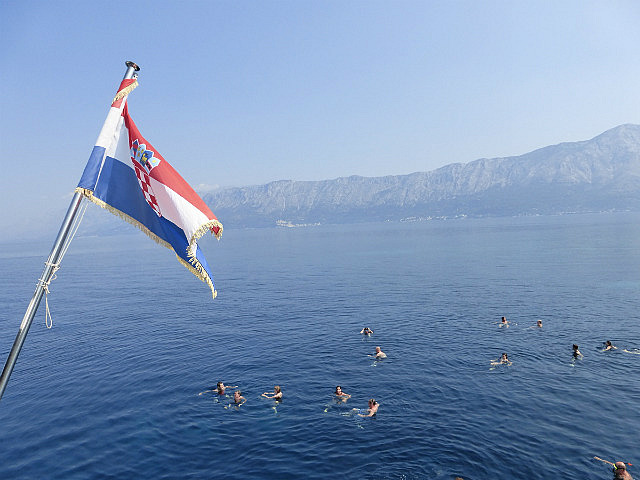
This concept has been referred to by students of culture as “digital vs analog”, meaning that the “digital” West has learned to take information and organize it more tightly, to order the data in a more linear format so that it can be applied more broadly. Think of the franchise concept in business where processes are simplified to a degree that the production can be easily replicated, hence more easily sold in larger quantities. This more production concept characterizes, in general, our Western attitudes towards efficiency, time, and relationship.
In contrast, the “analog” Eastern/Traditional point of view has more to do with a less organized approach to life, and places a greater emphasis on relationship. In general, it is more important to maintain relationship than to be productive in this kind of culture. Any North American who has traveled in Mediterranean countries has likely experienced this kind of cultural difference. Dinner is served much later. People take siesta and spend more time talking with each other. Getting things done in what we consider a timely, efficient manner is not as important in the Mediterranean. In the digital/analog model, this attitude toward life is more on the analog side. There’s much more that could be shared about this evaluation of culture, but hopefully, this suffices as an introduction to today’s planning activities on the island of Brač.
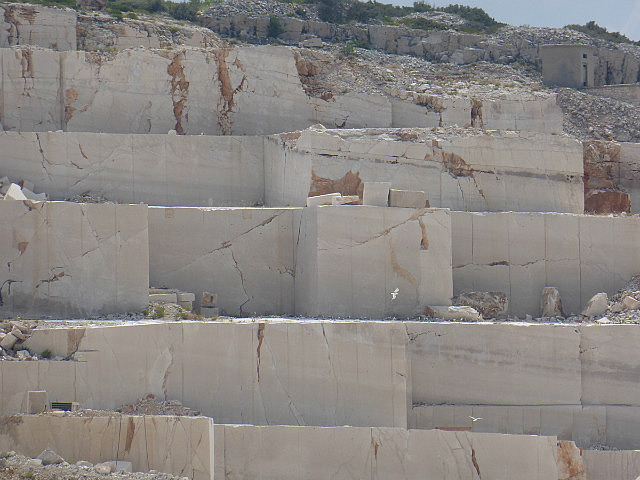
We docked in the town of Pucisca around 3:30 pm. Scott and I were intent on renting a car in order to explore other parts of the island to develop a walk. One of the challenges of using a ship program as the base of our itinerary is maximizing time in port, and finding transport to do that. It was Sunday, and we learned from Alex, our cruise director, that there are no car rental agencies in town. This surprised us since we’d been in neighboring Korcula the evening prior and saw multiple opportunities there to rent scooters and cars.
Alex spoke with the harbormaster and learned that one of the families in town rents motor scooters. Just a couple hundred meters from our ship, a café had a couple of scooters parked outside on the street. Turns out these were for rent, but ultimately, we learned that they also had a couple of cars “for hire”. The fellow who ran the café with his family told us we could hire the new car, with a driver, or the old car, without a driver. Wanting more control over the driving, and not knowing what kind of roads we might end up on, we opted for the old car.
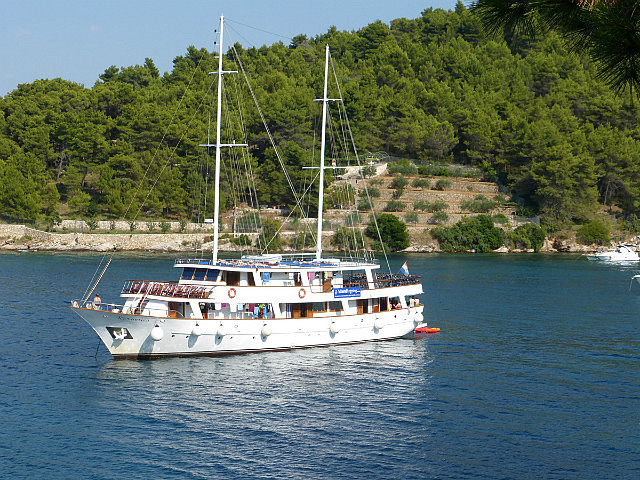
Old, in this case, meant pretty beat up: no air conditioning, an iffy fuel feed system that led to frequent stalling, a shift pattern that didn’t match the diagram on the gear shift, and a general appearance of vehicular fatigue and abuse. The guy renting the car had no paperwork, no rental agreement, and required only that we leave him my driver’s license (Scott was our driver). He drove with us up to his home to get the car registration (in case we were stopped by police), then waved us farewell. This, dear reader, is a prime example of an analog approach to the transaction of renting a car, as opposed to the highly structured process involved with any American car company rental transaction.
Scott has quite a bit of European driving experience and was looking forward to the challenge of the narrow winding roads of the island of Brac. In spite of vehicular fatigue, we soon found ourselves zipping along the main north coast highway, bound for Lovrecina Bay, and a coastal walking route we hoped would meet our goals. The islands of Dalmatia are generally a hardy lot – cloaked in limestone ridges and offering a seemingly endless number of lovely coves and harbors.
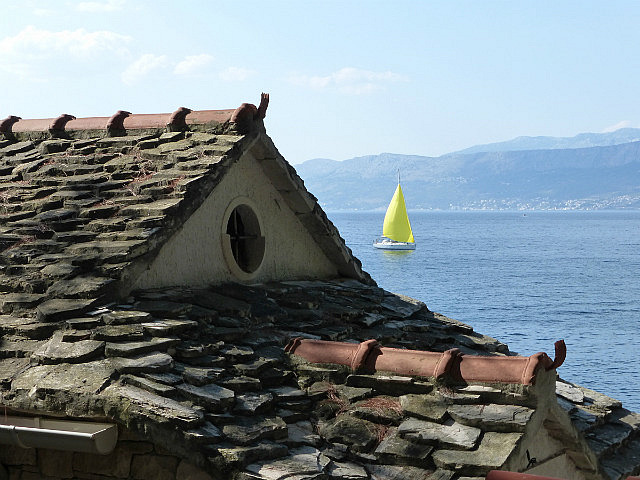
Our intended trail turned out to be very pleasant, hugging the coast for 3 miles between Lovrecina Bay and the delightful town of Postira. We walked most of it, then doubled back to get the car, drove into Postira to pick up the trail there, and used the car to economize on time by driving as far as we could towards the harbor. Every coastal town is understandably centered around its harbor, many of which have been converted into tourism magnets with charming little cafes and restaurants ringing the water. Postira has a delightful waterfront, as yet undiscovered by the masses at Dubrovnik, Split, and Hvar.
Feeling satisfied with the 3 miles of trail along the north coast of Brac, we drove north to a tiny enclave called Skrip in the hills above Postira. The town of Skrip is mentioned in our guide books as the birthplace of Helena, mother of Constantine. Map research indicated we might be able to hike down from Skrip to one of the coastal cities – Postira or Splitska.
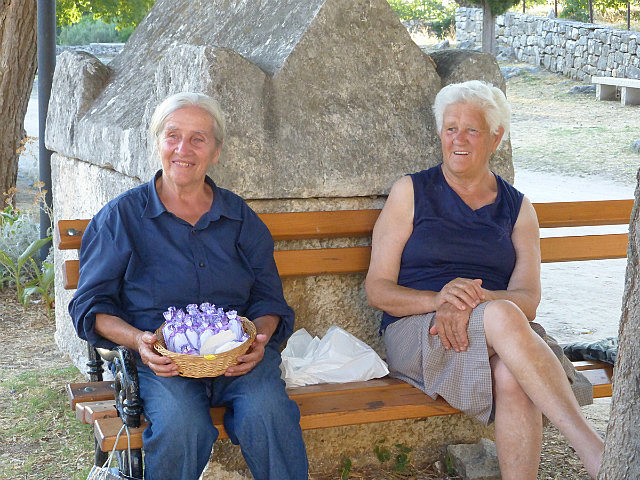
Arriving into Skrip, it was easy to spot the church dedicated to Helena (Jelena in Croatian). We parked the car, encouraged by the rustic appearance of the area. All the buildings were built with local stone, and the late evening sun made the warm hues of the limestone shimmer. As we approached the church, a trio of older women tempted us with offers of wine tasting and lavender. We purchased a few posies of lavender and continued exploring. Behind the St. Helena Church, a path led down to a grouping of dilapidated stone houses, overgrown with vegetation, in various states of dramatic collapse, and looking like a set for a Harry Potter or Lord of the Rings classic.
Since our intended route headed down the mountain on the opposite side of the church, we followed the trail inland, hoping for the opportunity to loop back around to the church, which it did. Back at the church, the same three gals hit us up again, one of them speaking in German with an offer to observe a demonstration of a 300 year old process of producing olive oil. She was such a charmer that it was difficult to pass, but fading light provided the necessary sense of urgency and we thanked her and moved on.
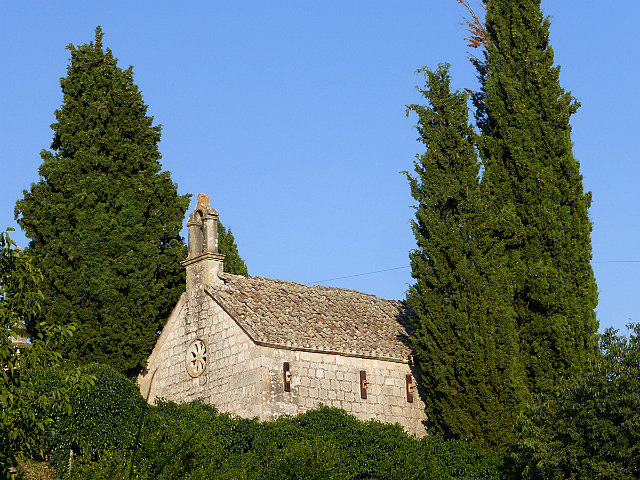
This tiny berg also hosts a museum of artifacts from throughout the millennia! The foundations of the museum are said to predate the Romans, going back to the original people group – the Illyrians. As the oldest community on Brac, it is no surprise that its collection includes statuary from the Roman period, and even bones dated back several thousand years before the Romans. I was stunned at the contrast between the quality of material displayed relative to the humble manner in which it lay unprotected and inconspicuously labeled, like some collection of 100-year-old Americana artifacts in a small town USA museum.
Scott and I enjoyed the loop walk, the obvious age and traditional construction of the buildings, the historical connections with the Illyrians, the Romans, the mother of one of Rome’s most notable emperors, and the fun interactions with modern day locals who were clearly and delightfully lodged in a Dalmatian time-warp.
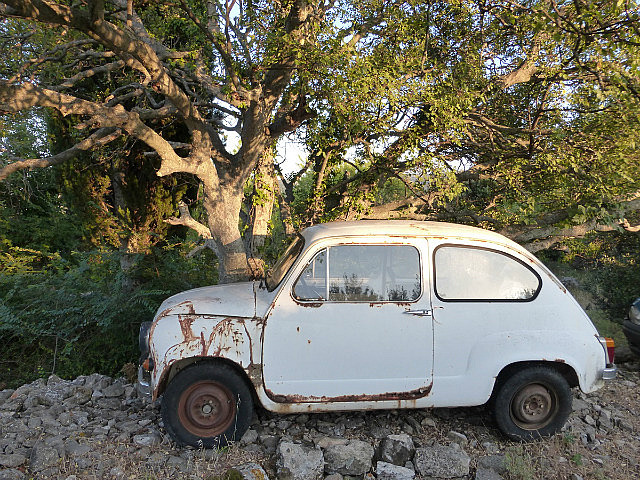
Finishing the loop at the St. Helena Church, we left Skrip on a farming road that dropped over the hill into olive groves. The sun was setting to our left as we took in panoramic views over the channel to the 5000 foot tall ridges of the mountains along the Dalmatian coast. Further down, we passed many of the mounds of stone, testament of ages of labor, clearing the land for farming. Scott and I parted ways half way down, and he returned to the car. We rendezvoused at the highway on the north end of the trail, now lit by a full moon, and pointed our “rental” car back to Pucisca.
The outdoor café where we had picked up the car was lively when we arrived at 9:30 pm. We traded cash payment (credit cards are not welcome and not even used for security on the car) for my license with the owner, having accomplished our walk planning mission, then took seats on the terrace for a couple of pizzas and a bottle of the local red wine. The evening was pleasant, and we reveled in the awareness of our remote location in a tiny Dalmatian town at the end of an Adriatic island where time stands still.
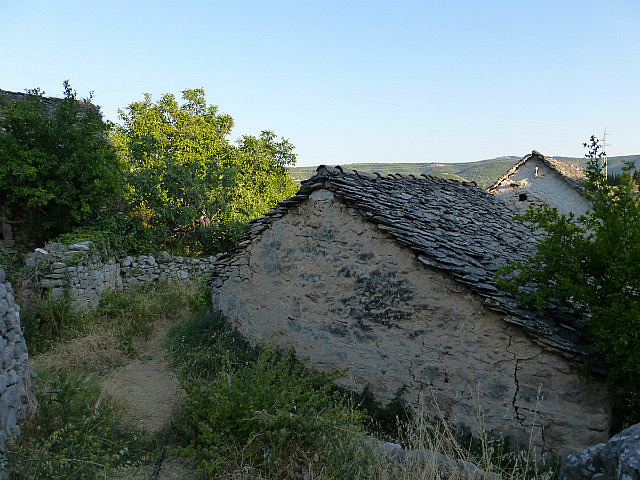
As a sign of appreciation, our host brought a plate of delicious Nutella-fille crepes to our table for dessert. Scott and I agreed that when a relational analog society works, it trumps the production-oriented digital society every time![/vc_column_text][/vc_column][/vc_row][vc_row][vc_column][vc_gallery interval=”0″ images=”6782,6783,6784,6786,6789,6792,6793,6794,6795″ img_size=”large”][/vc_column][/vc_row]

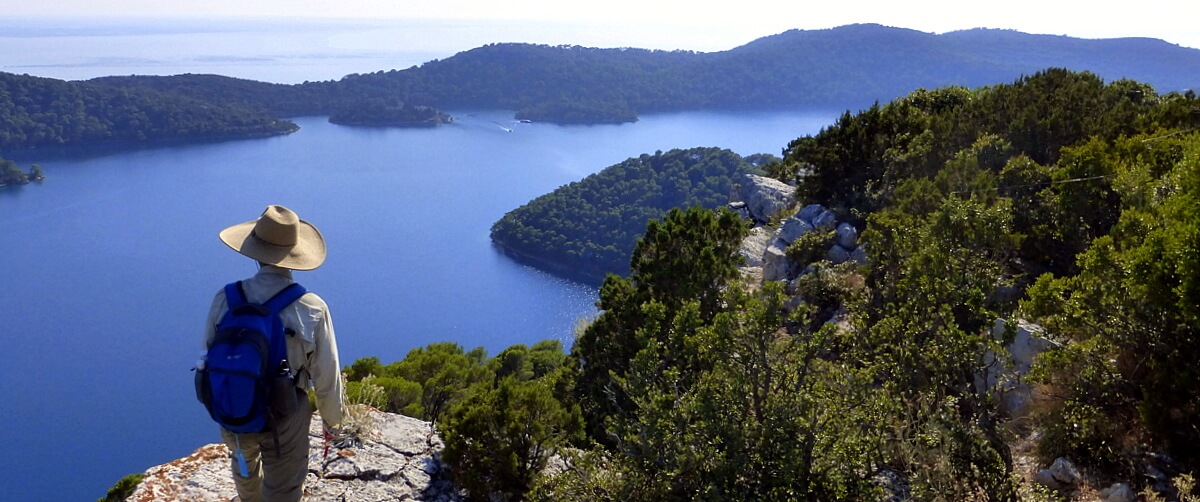
Loved your writing today…..sounds like a perfect walk planning day for you two!
Yes, Debbie, it was a perfect walk-planning day, though made a bit uncertain by the state of the car we rented and sun insisting on going down, leaving us in the dark. But it worked in the end!
Dear “FRIEND” Dan,
We so enjoyed the concept “digital WEST’ vs “analog EAST’.
We have so loved every Trip that we have taken with WAI—– First Class——- but Dan’s Blogs come a close second, for our enjoyment. THANKS, Dear “FRIEND. xox xox
Don & Joan, thanks for the kind words. It’s always gratifying to realize that someone is actually reading these things! In Herzegovina today – pretty amazing experience I hope to blog about soon. Take care and blessings on you both!